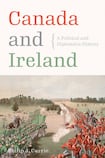
The Halibut Treaty, negotiated between Canada and the United States in 1923, was the first international agreement designed to conserve a salt-water fish species. It limited the commercial fishery in the northern Pacific in waters shared by Alaskan and Canadian fishing fleets, and stands as a milestone in efforts to protect fish stocks and the environment.
And, surprisingly, it was also a milestone in the long march toward Irish independence. For the first time since 1867, when Canada became a self-governing dominion within the British empire, its officials had negotiated and signed an agreement with a foreign power without British diplomats at the table.
The government of the newly formed Irish Free State took note of this assertion of Canadian independence, and the delegates it dispatched to the 1923 Imperial Conference demanded – and won – the same right to sign treaties and craft its own foreign policy.
This “curious precedent,” as Canadian scholar Philip J. Currie terms it, is one of the many ways a country far removed from Ireland has influenced Irish affairs. For more than a century, he writes in his ground-breaking study of relations between these interconnected Atlantic Rim neighbours, “Canada would be involved in, intrigued by, and frustrated with the politics of Ireland”.
In Canada and Ireland: A Political and Diplomatic History, Currie, a native of Co Down, delves into a relationship bookended by two pivotal moments in Irish history. In 1866, a small army of Fenian extremists crossed the border from the United States on a futile mission to capture Canada in hopes of swapping their prize for a British withdrawal from Ireland. The Fenians morphed into the Irish Republican Army and Currie points out the irony that a retired Canadian general, John de Chastelain, headed the international commission established in 1997 to disarm the Provisional IRA and paramilitary groups in Ulster.
Constitutional usage
Canada’s greatest impact on Ireland is found in the self-government provisions of the Anglo-Irish Treaty of 1921. Article 2 placed Ireland’s relationship to the crown and the British government on the same footing as Canada’s, according to “the law, practice and constitutional usage” that had developed between Britain and Canada over the previous five decades. As the Halibut Treaty showed, this put the Irish Free State on a fast-track toward greater independence in lockstep with Canadians eager to shed their few remaining colonial ties.
Currie introduces a cast of little-known Canadians who dabbled in Irish politics.
Edward Blake, the leader of Canada’s official opposition for much of the 1880s, lost two elections before heading to Britain to improve his political luck. The son of an Irish immigrant and a Protestant, he was nonetheless a passionate supporter of Home Rule. He reinvented himself as an Irish Nationalist Party member of parliament, and defended Gladstone’s Home Rule initiative as “healing and restorative… not a measure of separation, or disintegration or decay”.
Behind the scenes Oscar Skelton, another Canadian with Irish Protestant roots – he described himself as “90 per cent Orange” – was pushing for both Canada and Ireland to assert their independence. A top bureaucrat in the 1920s with the ear of Canadian prime minister William Lyon Mackenzie King, he conspired with Irish officials to break free of British control and forge foreign policies that, as he put it, “began at home”.
Robert Borden, Canada’s prime minister during the first World War, offered an intriguing proposal to preserve Irish unity. In the 1920s, after leaving office, he advocated a federal system of government like Canada’s (with a national parliament and strong local governments) to safeguard the interests of the Protestant north and keep Ireland as a single state. Partitioning Ulster, he correctly warned British officials, would create a hard border that would endure for decades.
Oddest link
In perhaps the oddest link between the two countries, the momentous decision in 1948 to declare Ireland a Republic and withdraw from the Commonwealth was announced in the Canadian capital, Ottawa.
Taoiseach John Costello was there on an official visit, and Currie can only speculate on why this declaration of independence was not made in Dublin. Costello may have feared republicans back home were about to steal his thunder or it may have been an overreaction to a personal slight – Canada’s governor general had neglected to offer a toast to “the president of Ireland” at an official dinner.
From that point on, Canada found it had more in common with Northern Ireland (a cold war ally with a government “unapologetically British”, Currie writes) than with the Irish Republic. During the Troubles successive Canadian governments sympathised with the British but refused to take sides – with the French-speaking province of Quebec demanding greater autonomy and threatening separation, Canada could not afford to be seen either to support or oppose Irish nationalism.
Currie is writing primarily for a Canadian audience so Irish readers will find themselves on all-too-familiar ground as the book offers a crash course in Irish history. Yet they will also discover a succession of “who knew?” nuggets like the Halibut Treaty and how, in ways large and small, Canada has put its stamp on modern Ireland.
Dean Jobb’s next book recreates the crimes of Victorian-era serial killer Dr Thomas Neill Cream, who preyed on women in England, the US and Canada, and became known as London’s feared Lambeth Poisoner (Algonquin Books, 2021). He teaches non-fiction writing at the University of King’s College in Halifax, Nova Scotia.








